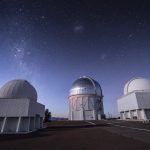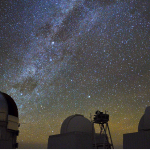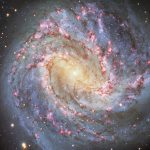The Dark Energy Survey has measured the BAO scale when the universe was half its present age with an accuracy of 2%, the most accurate determination yet at such an early epoch. It is the first time an imaging-only measurement is competitive with large spectroscopy campaigns specifically designed to detect this signal.
Dark Energy Survey
From National Geographic (Poland), Feb. 2, 2023: A group of 150 scientists, including researchers from Fermilab and the University of Chicago, has published one of the most precise measurements of the distribution of matter in the Universe. The analysis is groundbreaking because it used data from two very different telescope surveys and it indicated that something is missing in the current standard model of the universe.
From Big Think, Jan. 31, 2023: Fermilab researchers are part of a group who studied analysis from the South Pole Telescope and the Dark Energy Survey in a series of three scientific papers describing the expansion history of the Universe is tells a confusing tale. The predictions and measurements disagree slightly, it could be a hint that our theories about the Universe need to be revised.
From Physics, Jan. 31, 2023: Fermilab scientists are part of a group of researchers using cross-correlation measurements combining data from the Dark Energy Survey and the South Pole Telescope to determine cosmological parameters with greater precision. The analysis involved more than 150 researchers with results published as a set of three articles in Physical Review D.
From USA News Hub, May 10,2022: The Dark Energy Camera on the Víctor M. Blanco 4-meter Telescope, one of the most powerful cameras in the world just photographed two distant galaxies entwined in what’s been described as a “galactic ballet.” Read more about these amazing new images captured by the DECamera developed and tested at Fermilab.
From National Geographic, September 28, 2021: Recently, Fermilab ran over 200 computers to analyze Dark Energy Survey images that helped identify a new comet called the Bernardinelli-Bernstein. It is estimated the nucleus of the comet is about 93 miles wide, the biggest size estimate for a comet in decades.
From Phys.org, August 24, 2021: Using the powerful 570-megapixel Dark Energy Camera (DECam) created and tested by Fermilab for the DES, astronomers have discovered an asteroid with the shortest orbital period of any known asteroid in the Solar System.




